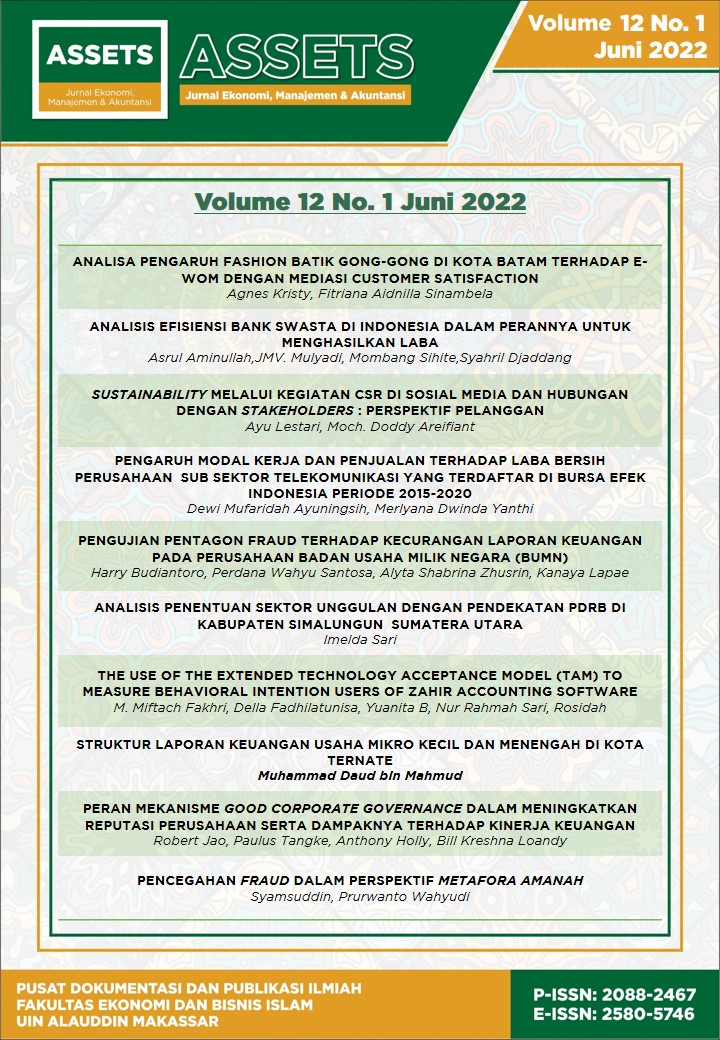THE USE OF THE EXTENDED TECHNOLOGY ACCEPTANCE MODEL (TAM) TO MEASURE BEHAVIORAL INTENTION USERS OF ZAHIR ACCOUNTING SOFTWARE
Abstract
A good accountant is the one who is able to do the preparation of financial statements. In addition, akuntan must gain an understanding of the financial reporting framework and significant accounting policies intended for use in the preparation of financial statements. Optimization of the preparation of financial statements that have been described above can be further realized by using software in the preparation of financial statements. One application or software that can be used in the preparation of financial statements is "Zahir Accounting". The purpose of the study was to find out the user's perspective on the zahir accounting application with the extended technology acceptance model (ETAM). The population in this study were Trainees in The Preparation of Financial Statements with the Zahir Accounting Application. The research had five main topics: perceived ease of use, usefulness, trust, enjoyment, behavioral intention. The data collection technique is a questionnaire through a google form. Data analysis using the Smart PLS application by hypothesis testing, namely structural models or inner models. The results showed that all eight hypotheses were accepted with positive effect results, but hypotheses 5 and 7 had no significant effect
References
AICPA. (2021). Preparation of Financial Statements.
Arikunto, & Suharsimi. (2002). “Sampling ratio”, in Suharsimi Arikunto Research Procedure: A Practical Approach. PT. Rineka Cipta.
Barclays. (2018). Will robots take our jobs? Diakses 25 Mei 2008. https://www.investmentbank.barclays.com/content/dam/barclaysmicrosites/ibpublic/documents/our-insights/Robots-at-the-gate/Barclays-IB_Will-Robots-Take-Our-Jobs_Infographic-1.6MB.pdf.
BusinessInsider. (2018). These Are The Jobs That Will Be Safe From The Imminent Invasion Of Robots. Diakses. http://www.businessinsider.com/jobs-that-will-be-lost-to-robots-2014-1/?IR=T.
Chellappa, R., Pavlou, K., & Paul, A. (2002). Perceived information security, financial liability and coonsumer trust in electronic commerce transactions. Logistics Information Management, 15(5/6), 358–368. https://doi.org/10.1108/09576050210447046
Davis, F. D. (1993). User acceptance of information technology: System characteristics, user perceptions and behavioral impacts. International Journal of ManMachine Studies, 38(3), 475–487. https://doi.org/10.1006/imms.1993.1022
Davis, S. G. (1986). Parades and Power: Street Theatre in Nineteenth-Century Philadelphia. Temple University Press.
F, D. (1989). Perceived usefulness, perceived ease of use, and user acceptance of information technology. MIS Quarterly, 13(3), 319–340.
F.D, D., R.P., B., & P.R, W. (1989). User acceptance of computer technology: A comparison of two theoretical models. Management Science, 35(8), 982–1003.
Forbes. (2018). The fastest and slowest growing jobs. Diakses. https://www.forbes.com/pictures/efkk45fmhd/the-jobs-with-darkest-future/#10b94fb9764a.
Gio, P. U. (2022). Partial Least Squares Structural Equation Modelling (PLS-SEM) dengan Software Smart PLS (Contoh Kasus dan Penyelesaiannya).
Guardian, T. (2018). What jobs will still be around in 20 years? Read this to prepare your future. Diakses. https://www.theguardian.com/us-news/2017/jun/26/jobs-future-automation-robots-skills-creative-health.
Hsu, C. L., & Lu, H. P. (2004). Why do people play on-line games? An extended TAM with social influences and flow experience. Inf. Manag, 41, 853–868.
Hu, P. J., Chau, P. Y. K., Sheng, & Tam. (1999). Examining the Technology Acceptance Model Using Physician Acceptance of Telemedicine Technology. Journal of Management Information System, 16(2), 91–112.
Ikatan Akuntan Indonesia. (2020). Kode Etik Akuntan Indonesia. Ikatan Akuntan Indonesia.
Institut Informatika dan Bisnis Darmajaya. (n.d.). Manual Book Pengoperasian Zahir Accounting 6.0. Institut Informatika dan Bisnis Darmajaya.
Irham. (2012). Laporan Keuangan (2nd ed.). Alfabeta.
Isnawan, & Ganjar. (n.d.). Akuntansi Praktis Untuk UMKM. Laskar Aksara.
Kabir, K. H., Hassan, F., Mukta, Most. Z. N., Roy, D., Darr, D., Leggette, H., & Ullah, S. M. A. (2022). Application of the technology acceptance model to assess the use and preferences of ICTs among field-level extension officers in Bangladesh. Digital Geography and Society, 3, 100027. https://doi.org/10.1016/j.diggeo.2022.100027
Khalilzadeh, J., Ozturk, A. B., & Bilgihan, A. (2017). Security-related factors in extended UTAUT model for NFC based mobile payment in the restaurant industry. Computers in Human Behavior, 70, 460–474. https://doi.org/10.1016/j.chb.2017.01.001
Kim, G., Shin, B., & Lee, H. G. (2009). Understanding dynamics between initial trust and usage intentions of mobile banking. Information Systems Journal, 19(3), 283–311. https://doi.org/10.1111/j.1365-2575.
Koenig-Lewis, N., Marquet, M., Palmer, A., & Zhao, A. L. (2015). Enjoyment and social influence: Predicting mobile payment adoption. The Service Industries Journal, 35(10), 537–554. https://doi.org/10.1080/02642069.2015.1043278
Lee, Y. H., Hsieh, Y. C., & Hsu, C. N. (2011). Adding innovation diffusion theory to the technology acceptance model: Supporting employees’ intentions to use e-learning systems. J. Educ. Technol. Soc, 14, 124–137.
Legris, Ingham, & Collerette. (2003). Why do people use information technology? A critical review of the technology acceptance model. Information & Management, 40(3), 191–204. https://doi.org/10.1016/S0378-7206(01)00143-4
Lyons, K., & Wearing, S. (2015). The Sharing Economy: Issues, Impacts and Regulatory Responses in the Context of the NSW. Sydney.
M., F., & I., A. (1975). Belief, Attitude, Intention, and Behaviour: An Introduction to Theory and Research. Addison-Wesley.
Manyika, J., Lund, S., Chui, M., Bughin, J., Woetzel, J., Batra, P., Ko, R., & Sanghvi, S. (2017). Jobs lost, jobs gained: What the future of work will mean for jobs, skills, and wages. Diakses. https://www.mckinsey.com/featured-insights/future-of-organizations-and-work/jobs-lost-jobs-gained-what-the-futureof-work-will-mean-for-jobs-skills-and-wages.
Mardhiyah, N. S., Rusydi, M., & Azwari, P. C. (2021). Analisis Technology Acceptance Model (TAM) Terhadap Penggunaan Aplikasi Gojek Pada Mahasiswa Di Kota Palembang. Esensi: Jurnal Bisnis dan Manajemen, 10(2), 173–180. https://doi.org/10.15408/ess.v10i2.16455
Maulana, R., Latifah, R., & Eka Jayanti, W. (2019). Aplikasi Komputer Akuntansi Zahir Accounting 5.1 (Vol. 7). Universitas Bina Sarana Informatika. http://ejournal.bsi.ac.id/ejurnal/index.php/khatulistiwa/article/view/5742
Money. (2018). The 6 Jobs Everyone Will Want in 2040. Diakses. http://time.com/money/4982643/6-future-jobs/.
Natasia, S. R., Wiranti, Y. T., & Parastika, A. (2022). Acceptance analysis of NUADU as e-learning platform using the Technology Acceptance Model (TAM) approach. Procedia Computer Science, 197, 512–520. https://doi.org/10.1016/j.procs.2021.12.168
Redzuan, N., Razali, A., Muslim, A., & Hanafi, W. (2016). Studying perceived usefulness and perceived ease of use of electronic human resource management (e-HRM) with behavior intention. International Journal of Business Management (IJBM, 1(2), 118–131.
Rupeika-Apoga, & Nedovis, U. (2015). The Foreign Exchange Exposure of NonFinancial Companies in Eurozone: Myth or Reality? International Journal of Economics and Business Administration, 3(1), 54–66.
Shih, H. P. (2004). Extended technology acceptance model of Internet utilization behavior. Inf. Manag, 41, 719–729.
Sukendro, Habibi, A., Khaeruddin, Indriyana, B., Syahruddin, Makadada, F. A., & Hakim, H. (2020). Using an extended technology acceptance model to understand students’ use of e-learning during Covid-19. Indonesian Sport Science Education Context, 6(11).
Thalassinos, Pintea, & Ratiu. (2015). The Recent Financial Crisis and Its Impact on the Performance Indicators of Selected Countries during the Crisis Period: A Reply. International Journal of Economic and Business Administration, 3(1), 3–20.
Theriou. (2015). Strategic Management Process and the Importance of Structured Formality, Financial and Non-Financial Information. European Research Studies Journal, 18(2), 3–28.
To, A. T., & Trinh, T. H. M. (2021). Understanding behavioral intention to use mobile wallets in vietnam: Extending the tam model with trust and enjoyment. Cogent Business & Management, 8(1), 1891661. https://doi.org/10.1080/23311975.2021.1891661
Toufaily, E., Nizar, S., & Ladhari, R. (2013). Consumer trust toward retail websites: Comparison between pure click and click-and-brick retailers. Journal of Retailing and Consumer Services, 20(6), 538–548.
Venkatesh, V. (2000). Determinants of perceived ease of use: Integrating control, intrinsic motivation, and emotion into the technology acceptance model. Inf. Syst. Res, 11, 342–365.
Venkatesh, V., & Morris, M. G. W. (2000). don’t men ever stop to ask for directions? Gender, social influence, and their role in technology acceptance and usage behavior. MIS Q, 24, 115–139.
W.E.F. (2018). The Future of Jobs. Diakses. http://reports.weforum.org/future-of-jobs-2016/.
Wijayana, S. (2018). Benarkah Peran Akuntan Digantikan Oleh Teknologi (Informasi)? Universitas Gajah Mada. https://feb.ugm.ac.id/en/research/lecturer-s-article/2886-benarkah-peran-akuntan-digantikan-oleh-teknologi-informasi
Copyright (c) 2022 Assets : Jurnal Ekonomi, Manajemen dan Akuntansi

This work is licensed under a Creative Commons Attribution-NonCommercial-ShareAlike 4.0 International License.










